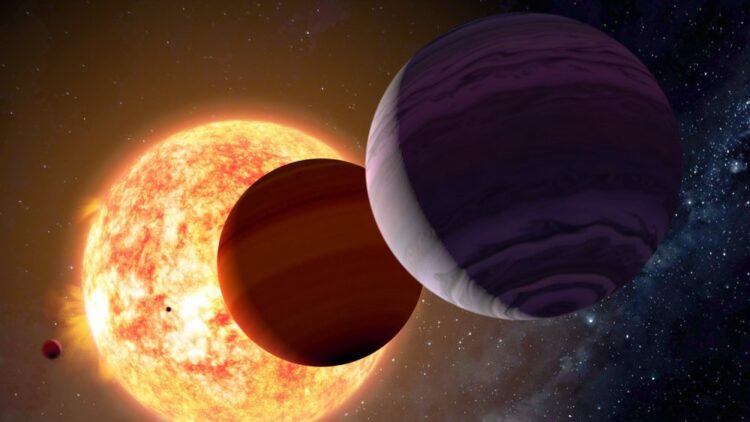Study reveals that giant planets could reach “maturity” much earlier than previously thought

Artist's impression of the planetary system V1298 Tau
Credit: Gabriel Pérez Díaz, SMM (IAC)
An international team of scientists, in which researchers from the Instituto de Astrofísica de Canarias (IAC) participate together with other institutions from Spain, Italy, Germany, Belgium, UK, and Mexico, has been able to measure the masses of the giant planets of the V1298 Tau system, just 20 million year old. Masses for such young giant planets had not been obtained previously, and this is the first evidence that these objects have already reached their final size at very early stages of their evolution. For this study they have used radial velocity measurements from the HARPS-N spectrographs, at the Roque de los Muchachos Observatory (ORM), and CARMENES, at the Calar Alto Observatory. The results are published today in the journal Nature Astronomy.
The study, led by the IAC researcher Alejandro Suárez Mascareño, reports the measurement of the masses of two giant planets that orbit the young solar-type star V1298 Tau. They were discovered in 2019 by a team lead by Trevor David (JPL) using data from NASA’s Kepler space telescope, which allowed the measurement of their sizes, slightly smaller than Jupiter, and of their orbital periods, 24 and 40 days for V1298 Tau b and e, respectively.
“The characterization of very young planets is extraordinarily difficult,” says Alejandro Suárez Mascareño, first author of the publication. The parent stars have very high levels of activity and until very recently it was unthinkable to even try ”. And he adds: “Only thanks to the combination of detections made with space telescopes, combined with intense radial velocity campaigns from Earth-based observatories and the use of the most advanced analysis techniques, it was possible to begin to see what is happening in such early stages of the evolution of planetary systems ”.In fact, for the new measurements of the planetary masses, it was necessary to separate the signals generated by these planets from the signal generated by the star’s activity, almost ten times larger.
The study shows that the masses and radii of the planets V1298 Tau b and c are surprisingly similar to those of the giant planets of the Solar System or in other old extra-solar systems. These measurements, which are the first to be obtained of such young giant planets, allow us to test current ideas about the formation of planetary systems. “For many years, theoretical models have indicated that giant planets begin their evolution as bodies with a larger size, and later they contract over hundreds millions or even billions of years ”, explains Víctor J. Sánchez Béjar, researcher at the IAC and co-author of the work. “We now know that they can actually reach a size similar to that of the planets in the Solar System in a very short time,” he notes.
The study of young systems gives researchers clues about what happened during the infancy of our solar system. “We still do not know if V1298 Tau is a normal case and its evolution is similar to that of most planets or if we are facing an exceptional case; if this were the normal scenario, it would mean that the evolution of planets like Jupiter and Saturn could have been very different from what we think ”, comments Nicolas Lodieu, a researcher at the IAC and also a co-author of the work. The results of this work thus help to build a more solid idea of the early evolution of planetary systems like ours.
To achieve the measurement of these masses, the study has required a significant observational effort and the collaboration of multiple observatories and institutions from different countries. It has been necessary to combine radial velocity measurements from various instruments such as the high-resolution HARPS-N ultrastable spectrograph, installed at the Roque de los Muchachos Observatory’s Telescopio Nazionale Galileo (TNG); the CARMENES high resolution spectrograph, installed at the Calar Alto observatory; the HERMES spectrograph, installed on the Mercator telescope, also at the ORM; and the SES spectrograph, installed in the STELLA telescope at the Teide Observatory. Observations taken from the Las Cumbres Observatory, a network of telescopes located around the world, have been used to continuously monitor the variations of the star’s activity.
In addition to the researchers Alejandro Suárez Mascareño, Victor J. Sánchez Béjar and Nicolas Lodieu, from the IAC researchers Rafael Rebolo López, Felipe Murgas, Jonay González Hernández, Carlos Cardona Guillén, Borja Toledo Padrón, Patricia Chinchilla, Emma Esparza Borges, Mahmoud Oshagh, Enric Pallé and Hannu Parviainen.
Journal: Nature Astronomy
DOI: 10.1038/s41550-021-01533-7
Article Title: Rapid contraction of giant planets orbiting the 20 million-years old star V1298 Tau
Article Publication Date: 2-Dec-2021
All latest news from the category: Physics and Astronomy
This area deals with the fundamental laws and building blocks of nature and how they interact, the properties and the behavior of matter, and research into space and time and their structures.
innovations-report provides in-depth reports and articles on subjects such as astrophysics, laser technologies, nuclear, quantum, particle and solid-state physics, nanotechnologies, planetary research and findings (Mars, Venus) and developments related to the Hubble Telescope.
Newest articles

Innovative 3D printed scaffolds offer new hope for bone healing
Researchers at the Institute for Bioengineering of Catalonia have developed novel 3D printed PLA-CaP scaffolds that promote blood vessel formation, ensuring better healing and regeneration of bone tissue. Bone is…

The surprising role of gut infection in Alzheimer’s disease
ASU- and Banner Alzheimer’s Institute-led study implicates link between a common virus and the disease, which travels from the gut to the brain and may be a target for antiviral…

Molecular gardening: New enzymes discovered for protein modification pruning
How deubiquitinases USP53 and USP54 cleave long polyubiquitin chains and how the former is linked to liver disease in children. Deubiquitinases (DUBs) are enzymes used by cells to trim protein…


